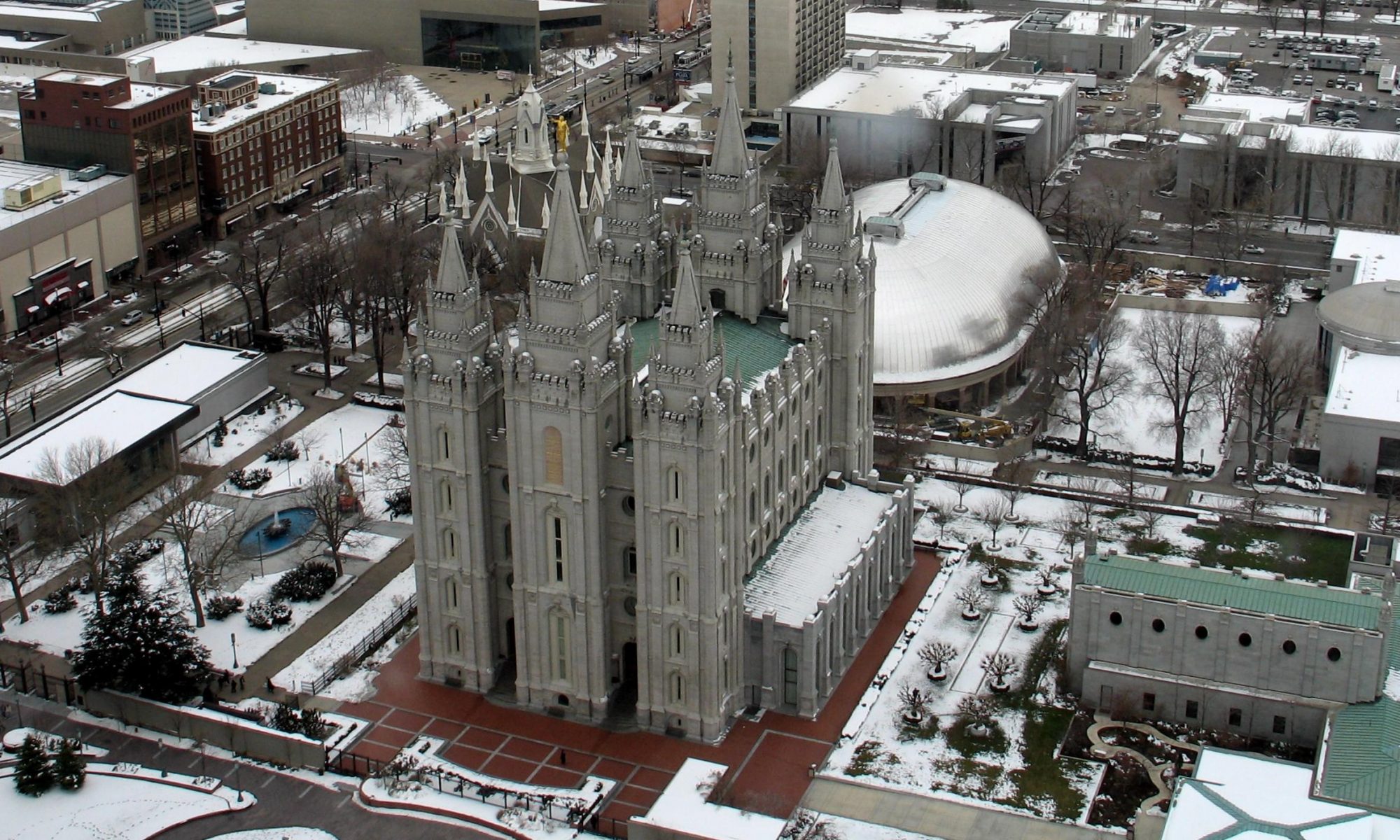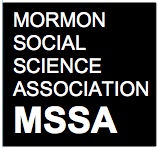Q: I am researching the recent changes in missionary work and am trying to find out how to get a hold of retention rates for the church as a whole. Do you have any idea how I might find this type of information? I am also trying to figure out how to get numbers of potential missionaries, that is, the number of young men ages 19 that are the right age to serve missions so that I might be able to compare percentages before and after raising the bar on missionary standards. Finally, I want to make sure I have not missed any recent works about this topic including dissertations, articles, etc.
A: This is an interesting question. Unfortunately, it is also one that is a bit difficult to answer, primarily because the LDS Church does not release the data it collects on its members. As a result, the best we can do as researchers is find alternative ways to estimate this information. You may find the following estimates useful.
First, regarding retention rates… As noted above, the LDS Church does not release this information. But there are ways to estimate this and several researchers have done so, giving us our current best estimates. For instance, Rick Phillips (2006), using census data for a variety of countries, compared the membership information supplied by the LDS Church in its annual almanac to the self-reported membership identifications of people in those countries and found that the LDS Church over-estimated its membership. The actual number of Mormons in those countries ranged from 20% to 70% of what the LDS Church claimed. The major implication of this finding is that retention rates of Mormon converts are fairly low.
Rick, in response to your question, gave this example: If data from the Canadian census is representative, then the disparity between official membership totals and the number of self-identified Latter-day Saints is increasing. LDS demographer (and MSSA member) Tim Heaton observes: “In the 1981 Canadian census … 82,000 people stated Mormon as their religious preference, yet LDS records reported 85,006 members. The difference implies that 3-4 percent of members on the records [at the time did not] consider themselves Latter-day Saints.” By the next decennial census this disparity had widened. In 1991, about 94,000 Canadians identified themselves as Mormons, but the church claimed 130,000. Thus, in the space of 10 years the LDS church went from over-reporting its Canadian membership by 3-4 percent to over 28 percent. The latest data show that this trend continues. The 2001 Canadian census lists 101,805 self-identified Mormons, compared to the church’s claim of over 160,000. This means that over a third of the Canadians now listed on LDS church rolls do not profess to be Mormons. Outside traditional Mormon strongholds in Alberta, disparities are even wider. A similar pattern is observed for New Zealand, and other MSSA members can probably report on other nations as well.
Rick also notes that, with respect to the United States, two censuses of religious bodies, conducted in 1990 and 2000 by the Glenmary Research Center, found that Mormon membership in the U.S. increased 19 percent between the two enumerations. The Glenmary data relies on information furnished by participating denominations, and hence this conclusion is based on figures provided by the LDS church. By contrast, two large-scale surveys of self-reported religious identification, the National Survey of Religious Identification (NSRI) and the American Religious Identification Survey (ARIS), conducted in 1990 and 2001 respectively, tell a different story. The 1990 NSRI estimates the adult LDS population at 2.5 million, while the 2001 ARIS estimates it at 2.7 million—an 8 percent increase. Differences between the Glenmary data and these self-report surveys imply that many of those who were baptized Mormon in this decade defected, but are still counted as members by the church. Kosmin, Mayer and Keysar write: “[Mormonism] appear[s] to attract a large number of converts (‘in-switchers’), but also nearly as large a number of apostates (‘out-switchers’)” This same finding is echoed in a new report by the Pew Forum on Religion and Public Life.
Rick Phillips has also pointed out that that retention rates are strongly negatively correlated with growth rates, and that those nations that have high growth rates have low rates of convert retention. Rick discusses Mormon convert retention in two articles, one currently published (2006) and one coming out in the next issue of JSSR (see references below). The bibliographies of these papers cite most of the research on this subject. If your library does not carry these journals, we can provide offprints.
Rick also suggested some other sources, depending on your definition of “retention.” If you want to define “retention” as some level of church participation, then Tim Heaton’s “Vital Statistics” entry in the Encyclopedia of Mormonism is the best place to start. You may also find this discussion of retention by Elder Oaks instructive.
There are some other sources of information on retention in the LDS Church. For instance, Henri Gooren (2008) found in his field research in Central America that half of all new members left the religion within a year; more leave after that. That would indicate retention rates lower than 50%. David Stewart, in his book on Missiology and Retention, claims various retention rates, but most center around 20% to 30% (see pages 257-280). Stewart cites several mission presidents in his book who admit retention rates ranging from 8% to 18% (p. 278). Unfortunately, many of the retention rate estimates in Stewart’s book are not referenced and it is unclear how he arrives at his numbers.
In sum, best estimates of retention rates for converts to Mormonism would probably put the number somewhere between 20% and 50%, depending on the country.
As regards your second question of potential missionaries… There are really two components here. The first is the actual number of potential missionaries and the second would be their potential impact on growth of the religion. Rick Phillips, in his response to your question, noted that the only sure way of finding out the number of 19 year olds would be to contact the Research Division of the LDS Church. Whether they would release that information is not clear, but you could try. However, there is a way to arrive at an estimate for the US. The US Census Bureau generates population estimates by age and sex for each state every year. The latest year of data available is 2007 (http://www.census.gov/popest/datasets.html). Using that data, you can create population pyramids (a demographic technique) that illustrates the age/sex structure of a population. Ryan Cragun used that data to generate four population pyramids (see Figures 1 through 4 attached below). While it is true that Utah is decreasingly a good proxy for Mormons in the US, generally, careful scrutiny of the population pyramids does give an indication of the number of young men moving into mission ages. What you see in Figure 4 (the Utah population pyramid from 2007) is a large difference in males in the 21-25 age range compared to the 16-20 range. That large difference would suggest that the number of Mormon missionaries is going to drop substantially in the coming years (and probably helps explain the large recent drop in missionaries). Considering the 11-15 and 6-10 year age ranges are closer to the 16-20 age range in size, the smaller number of missionaries (from Utah at least) is likely to continue for the next 15 years or so. However, there is a possibility that the lower numbers in Utah (and the US, generally) may be slightly offset by growing numbers of missionaries outside the US as population pyramids outside the US in developing countries are much wider at the bottom (in younger age ranges) than at the top. But all of this also depends on the percentages of 19 year olds who serve missions, a number that is also unknown except by the LDS Church. Additionally, the reduction of missionaries may be due to the “raising the bar” efforts of the LDS Church in the early part of this decade, but the demographic shift seen in Figure 4 seems to suggest otherwise.
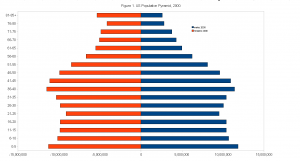
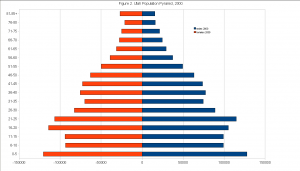
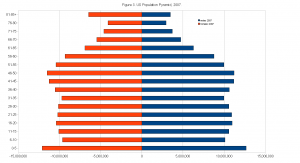
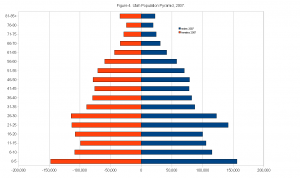
If you couple the declining 19 year old population with the lower returns from missionary efforts, the future of Mormon growth looks even more interesting. Rick Phillips noted in his response to this question that the number of convert baptisms per missionary has fallen over the last 20 years. In 1986, there were 6.3 baptisms per missionary, in 1997 this fell to 5.6 converts per missionary, and the latest almanac shows 5.1 baptisms per missionary for 2007 (David Stewart estimates it as 4.5 converts/missionary from 2000 to 2004; see p. 23). Thus, the smaller number of eligible young men to serve missions combined with the lower returns of their efforts (and other factors) indicate Mormon growth is probably going to continue to slow.
One last item you may find interesting is the attached Balance Sheet of Mormon growth in the US by MSSA member Richley Crapo (attached below). It shows that LDS growth in the US is much lower than the actual conversion rate.
Hopefully this answers your questions. If you have any other questions, please let us know.
References:
Gooren, Henri. 2008. “The Mormons of the World: The Meaning of LDS Membership in Central America.” Pp. 362-388 in Revisiting Thomas F. O’Dea’s The Mormons: Contemporary Perspectives, edited by Cardell K. Jacobson, John P. Hoffman, and Tim B. Heaton. University of Utah Press.
Phillips, Rick. (2006) “Rethinking the International Expansion of Mormonism.” Nova Religio: The Journal of New and Emergent Religions 10(1):52-68.
Phillips, Rick. (In press) “‘De facto Congregationalism’ and Mormon Missionary Outreach: An Ethnographic Case Study.” Journal for the Scientific Study of Religion 47(4):628-643.
Stewart, David G. 2007. The Law of the Harvest: Practical Principles of Effective Missionary Work. Henderson, NV: Cumorah Foundation.
Update 1: Fri, 2008-11-21 23:52 — Shawn Bennion
I would like to point out on Richley Crapo’s chart that the net gain in Mormon membership (E4) does not include children of record in the United States for 2007. Though I do not have a specific number, this would add to the net total, meaning that the church growth for the year would be higher than the U.S. general birth rate. While I understand that his intent was to show movement through agency, I feel that this is still an important factor in terms of growth trends of Mormonism.
Update 2: Sun, 2009-08-16 08:07 — David Stewart
Terminology needs to be clearly defined, as activity is officially defined as the number of members who have attended church at least once in the past three months, whereas activity rates are regarded colloquially (and by many sociologists) as the percentage of members attending church on a given week. The latter number is more meaningful, and more measurable, although it is not technically an “activity rate” according to the Church’s definition.
It is stated above that “David Stewart, in his book on Missiology and Retention, claims various retention rates, but most center around 20% to 30% (see pages 257-280)…Unfortunately, many of the retention rate estimates in Stewart’s book are not referenced and it is unclear how he arrives at his numbers.” This is because the wrong section in my book is cited above. Pages 257-280 principally comprise the chapter “Understanding the Conversion Process” which deals with theoretical issues and matters of practical implementation.
The references on LDS activity and convert retention rates are found primarily in the chapter “Trends in LDS Member Activity and Convert Retention,” pp. 36-50, online here. Every statistic there is referenced, and so there should be no confusion regarding how any number has been arrived at.
Additional data can be found in my “LDS Church Growth, Member Activity, and Convert Retention: Review and Analysis” which is online here. This review includes itemized data from relevant sources (national censuses, independent sociologic studies, statements of church leaders, and quasi-official sources like the Encyclopedia of Mormonism) divided by geographic region, with the pertinent supporting references, and a discussion of key considerations which are essential to the proper analysis and understanding of LDS growth and retention data (double affiliation, address unknown file, survey methodology, unknown denominator, outcome reporting bias, and so forth).
That individuals identify themselves as Latter-day Saints on national censuses in Chile, Brazil, Mexico, the Philippines, etc., does not necessarily imply that they attend church, but one can be fairly confident that those who do not identify themselves as members do not attend. Such data thereby define “ceilings” on possible participation, even if the lower limit is difficult to precisely define. However, there are relatively few believing but non-participating members outside of the U.S. (see articles by Van Beek, Decoo, Numano, and others in the Spring 1996 Dialogue). By aggregating membership participation, affiliation, and self-identification data by country or region, it is clear that the number of Latter-day Saints attending church worldwide on any given Sunday cannot exceed 35% of nominal membership. My best estimate is that the true figure is likely in the 28-33% range; the limitations of currently available data do not permit greater precision than this.
